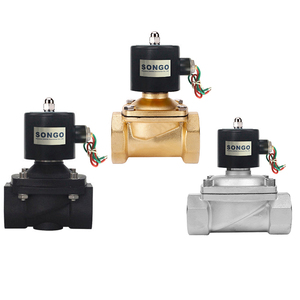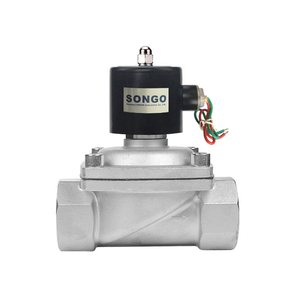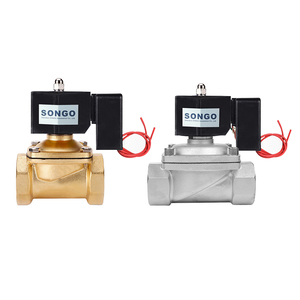
All categories
Featured selections
Trade Assurance
Buyer Central
Help Center
Get the app
Become a supplier

(663 products available)


















Electric pinch valves are crucial for regulating or controlling liquid passage in tubes. These valves frequently find application in the food, textile, paper, chemical, and pharmaceutical industries. Moreover, the electric pinch valve is utilized for slurry with solid content. These valves comprise an elastomeric body that creates a sealing area, a tubular structure that resembles a pipe, and an actuator that pinches the body to control the fluid.
Consequently, electric pinch valves have diverse types based on functionality, features, and materials. Here are some of the common types of electric pinch valves:
Automatic pinch valves
These valves operate without manual intervention and adjust automatically based on predefined parameters such as pressure, temperature, or flow rate. Automated pinch valves incorporate sensors and control systems for real-time data feedback and valve adjustment. Therefore, they efficiently regulate processes, which minimizes the need for constant human supervision.
Electric actuated pinch valves
These valves utilize electric actuators for control. The actuators provide precise control of the valve opening and closing, thus improving operational efficiency. Electric actuated pinch valves are especially useful in remote operations where manual control is impractical. These applications tend to be in automation-heavy industries, such as water treatment facilities.
Solenoid pinch valves
Solenoid valves control the pinch operation using electromagnetic solenoids. When energized, the solenoid retracts or moves a plunger that releases the pinching mechanism. These pinch valves are suitable for low- to medium-pressure applications and often feature simple on/off control. Furthermore, solenoid valves suit applications requiring quick switch-over and are very effective in automation.
Manual pinch valves
These valves require human operation to control the valve mechanism. Manual pinch valves are sometimes provided with handwheels or levers that are used by the personnel to adjust the valve. Though they allow more flexibility and precision during control, these valves are more suited for low-volume or infrequent processes. Lastly, the manual pinch valves are more commonly applied in smaller operations or areas that necessitate close monitoring.
Industrial electric pinch valves
Industrial pinch valves are specifically designed to sustain the harsh conditions commonly encountered in industrial settings. These electric valves are often made of extra-strength materials to endure elevated temperatures, high pressures, and corrosive substances. In addition, they are implemented in industries like mining, chemical processing, and power generation and are designed for durability and reliable performance.
To understand how these valves operate, it is important to break the electric pinch valve down into its key components. The main parts of an electric pinch valve include the pinch valve body, the actuator (which is electric), the control interface, and the valve seat.
This is because the actuator is responsible for creating force and comes in different types, like pneumatic-actuated pinch valves and hydraulic pinch valves. For instance, pneumatic actuators use compressed air to drive a piston or rotor that moves the pinch mechanism. By contrast, hydraulic actuators employ controlled fluid movements to create piston-driven forces. Therefore, depending on the actuator type, the valve's responsiveness and power capacity vary. While pneumatic ones improve swift operations, hydraulic ones are suitable for high-pressure applications.
The control interface is another significant pinch valve part, wherein the control interfaces manage actuator responsiveness. These may consist of manual dials, electronic controllers, and programmable logic controllers (PLCs), which enable the operator to tailor valve performance depending on process requirements. By doing so, they enhance operational flexibility and precision.
Additionally, the valve seat forms a sealing element within the pinch valve. When the pinch valve closes, the pinch body compresses the valve seat, thus creating a tight seal. This prevents fluid leakage and ensures proper flow interruption. Moreover, valve seats can be made from different materials. These include rubber, PTFE, and elastomeric compounds, which are ideal for distinguishing between various applications.
Therefore, when all these components work together, the electric actuator gets signals from the control interface. It then activates, moving the pinch body closer to the valve seat to turn off the fluid flow. Conversely, the actuator allows the pinch body to move away from the valve seat with the control interface, thus restricting the fluid flow. This flow control is significant since adjusting fluid movements permits precise voltage regulation.
The electric pinch valve's operating principle involves the electric actuator, pinch body movement, control interface, and valve seat interaction. Each component plays a crucial role, thus allowing for smooth flow control and management. As a result, these valves find diverse applications across multiple industries. This is because of their precision, durability, and ability to control challenging fluids.
Using electric pinch valves is underpinned by their versatility and ability to efficiently handle diverse fluids.
Water treatment
Electric pinch valves control fluid flows in wastewater and water treatment facilities. They provide reliable and leak-free shut-off, particularly on slurry and suspensions with solids. Due to their precise control over flow rates, these valves help maintain optimal chemical dosages and processes, thus improving efficiency and system reliability.
Mining and mineral processing
The electric pinch valve's robust design and ability to control abrasive slurries make it an ideal application in the mining industry. These valves regulate the flow of ores, mineral slurries, and other abrasive substances. Thus, they ensure durability and longevity when dealing with challenging materials.
Chemical and petrochemical industry
These industries typically deal with corrosive and viscous fluids. Therefore, electric pinch valves made from corrosive-resistant materials, such as PTFE or rubber, are ideal for these applications. They provide the necessary chemical resistance and precise flow control. Hence, ensuring the safe and effective movement of hazardous chemicals while safeguarding equipment integrity.
Pharmaceutical industry
Used in this industry, electric pinch valves are vital in regulating the flow of API (Active Pharmaceutical Ingredients), chemicals, and other sensitive fluids. Since they feature a no-retention design, the valves ensure hygienic fluid movements that tend to be essential for maintaining product quality and safety. In addition, these valves offer sterile operation and precise control. Therefore, making them suitable for the delicate processes of this industry.
Bulk handling and conveyance systems
In these systems, electric pinch valves control the flow of bulk materials, such as powders, granules, and solid/liquid mixtures. Furthermore, due to their quick response and automation capability, these valves integrate easily into pneumatic conveying systems. As a result, they enhance operational efficiency by providing precise on-demand flow control.
Food and beverage industry
Electric pinch valves control flow rates in this industry during processing and transportation. Because of their hygienic design and non-intrusive operation, they handle delicate liquids, purees, and suspensions. Additionally, these valves come in handy when processing food and beverages since they do not contaminate the products and keep them safe.
When purchasing an electric pinch valve, several key factors need to be considered. These factors ensure that the correct valve is chosen for the specific application required. Here are some of the crucial factors that businesses should consider when selecting an electric pinch valve:
Fluid type
The fluid being processed directly impacts the chosen valve material. For instance, the electric pinch valve's internal and external parts should be made from corrosive-resistant materials. These materials include brass, stainless steel, and PTFE. This is because the valve will handle fluids like acids, alkalis, or salt solutions. On the other hand, if the valve is to handle fluids containing solids, robust materials like rubber or hardened alloys should be used to resist abrasions.
Pressure and temperature
The electric pinch valve should seamlessly operate within the expected pressure and temperature ranges without failing. Each valve has a specific pressure threshold. Therefore, going past these thresholds can lead to undesirable outcomes like leaks or valve damage. On the other hand, temperature is another significant factor that needs consideration. For instance, if operations involve extreme temperatures, the valve material and design must guarantee effective performance under such conditions.
Valve size
The electric pinch valve size is critical since it influences the flow rate and overall system efficiency. The valve's diameter needs to be compatible with the tube's diameter to guarantee a balanced flow control. A small-sized valve limits fluid flow, whereas a large-sized valve creates turbulence and inefficient flow if too large. Therefore, properly assessing fluid flow rates and system needs aids in determining the ideal valve size.
Control requirements
One of the benefits of electric pinch valves is their control flexibility. In addition, businesses should consider their control level needs. For instance, do they need simple on/off operations, or do they require more complex modulation capabilities? Various control types to choose from include manual pinch valves, solenoid valves, and pneumatically controlled pinch valves. Each of these types offers distinct control precision levels. Therefore, selecting the one that aligns with the control needs will enhance operational efficiency.
Installation and maintenance
Although electric pinch valves have diverse installation requirements to consider, they are relatively easy to install. For instance, some may require additional supports or alignments, whereas others can be fitted directly into existing pipelines. A few maintenance needs can hamper long-term performance. Luckily, many electric pinch valves are designed with minimal maintenance demands. Some even feature self-cleaning capabilities.
Cost considerations
Lastly, since cost is one of the principal factors when selecting any equipment, electric pinch valves are no different. Businesses should do this while considering the long-term benefits and potential savings. Hence, it is crucial to look beyond initial capital expenditures and contemplate maintenance costs, operational efficiency, and the valve's lifespan. Doing this allows them to find the balance that will meet their budget and performance needs.
A1.An electric pinch valve is a controlling device that regulates fluid flow through a pipeline by pinching its elastic tube using an electric actuator. These valves provide precise control and are ideal for handling challenging fluids in industrial applications.
A2.The electric pinch valve suits multiple industries, such as water treatment, mining, chemical processing, and pharmaceuticals. They are particularly beneficial in the food and bulk handling and conveying systems due to their versatility and durability.
A3.Electric pinch valves' main advantages are precise flow control, automation capable, and no-retention design for easy hygiene maintenance. Their robustness makes them ideal for managing abrasive or viscous fluids in demanding environments.
A4.Electric pinch valves are of various types, including automatic, solenoid, pneumatic, and manual electric pinch valves. Each type has advantages, thus making them suitable for distinct applications based on operational needs and control requirements.
A5. The electric pinch valve works by an electric actuator that receives signals from a control interface. After that, it will compress the pinch body against the valve seat to control fluid flow, thus allowing the valve to regulate movements precisely.
A6.A business should consider several key elements when purchasing electric pinch valves. These factors include fluid type, pressure, temperature, valve size, control requirements, installation, maintenance, and cost considerations. Therefore, evaluating these factors will help them select an ideal electric pinch valve that will meet their operational needs effectively.